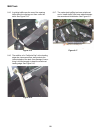
M48 Tank
28
• Do not connect a battery charger to the TANK
with the key switch turned on.
• The ECU requires at least 7.0 volts to function.
• If the battery goes dead, or is disconnected, the
adaptive memory in the ECU will be cleared. It
will take 10-15 minutes of running, at normal
operating temperatures, under a variety of loads
and throttle settings to re-learn the full envelope
of performance. Clearing the memory will also
clear diagnostic trouble codes.
• The ECU receives signals from a variety of sen-
sors. These include: crankshaft speed and posi-
tion, throttle position, engine temperature,
oxygen content of the exhaust gas, battery volt-
age.
• There is an indicator light that flashes diagnostic
codes in the event that there is a malfunction. If
the signal from any of the sensors are not in the
range that the ECU is expecting from compari-
son to its adaptive memory, a code will flash.
• In the event of a malfunction, the ECU has a
“limp home” mode that will allow it to plug in a
fixed value in place of the reading from the mal-
functioning sensor.
11.12. The Throttle Position Sensor tells the ECU what
the position of the throttle plate is. It is essen-
tially a potentiometer. See Figure 11.12.
• If a TPS fails, it will result in rough or erratic
engine performance. If a “dead” spot develops
in the potentiometer, the engine will run badly
whenever the throttle is in a position that corre-
sponds with the “dead” range of the TPS.
• The TPS can be checked with an Ohm meter,
looking for “jumps” as the throttle is swept
through its full range of travel.
• If the TPS mounting is disturbed for any reason,
there is a Kohler-specified initialization proce-
dure that must be performed.
11.13. The engine temperature has a bearing on the
fuel/air mixture and ignition timing. The ECU
“takes the engine’s temperature” with a ther-
mometer in the engine oil.
• When the engine is cold, the oil temperature is
the same as the ambient temperature. Being an
air-cooled engine, as the engine warms-up, the
oil temperature reflects a balance between
engine load and ambient temperature when
operating normally. This is sufficient for the pur-
poses of the ECU.
• A bad temperature sender may result in rich fuel/
air mixture accompanied by an erratic idle and
somewhat reduced WOT power.
• At 68deg. f, (20deg. c), the Ohm reading across
the terminals of the oil temperature sensor
should be in the 2375-2625 υ range.
11.14. In order to coordinate the timing of the fuel injec-
tor triggering, as well as tune the fuel delivery
and ignition timing to match the load applied to
the engine, the ECU needs to know the speed
that the crankshaft is spinning and the position
of the crankshaft.
• There is a 60 tooth ferrite ring gear on the fly-
wheel. This ring gear is separate from the
starter motor ring gear. A Hall-effect pick-up
mounted .049”-.069” from the ring gear gener-
ates a pulse as each tooth passes by. The ECU
counts the pulses to determine engine RPM.
• There are two consecutive teeth missing from
the ring gear. The ECU gets a signal from each
of the present teeth every 6 degrees of crank-
shaft rotation. The 12 degree gap is positioned
84 degrees before cylinder #1 reaches TDC.
This tells the ECU where the engine is in terms
of piston position.
• Each time the engine is started, it will take 720
degrees of crankshaft rotation for the ECU to
“find” the piston and begin working.
• Comparing engine speed to throttle position, the
ECU can interpolate the engine load.
• If the cranks trigger signal fails to reach the
ECU, the engine will not run.
Figure 11.12


















